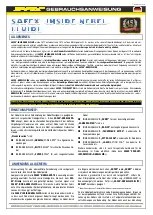
OSHA FACT SHEETS
CARBON MONOXIDE POISONING
U.S. Department of Labor
Program Highlights
Fact Sheet No. OSHA 92-11
What Is Carbon Monoxide?
Carbon monoxide -- a colorless, odorless, tasteless gas -- is one of the most common industrial hazards.
Mild poisoning can cause such symptoms as nausea, dizziness, or headaches while severe poisoning
can result in brain or heart damage or even death. The incomplete burning of any material containing
carbon, such as gasoline, natural gas, oil, propane coal, or wood, produces this poisonous gas. Forges,
blast furnaces and coke ovens all produce carbon monoxide, but one of the most common sources of
exposure in the workplace is the internal combustion engine.
Be suspicious of carbon monoxide poisoning if you develop headache, flushed face, dizziness, or
weakness. Bear in mind that although carbon monoxide has no telltale odor, it may mix with gases that
do have an odor. Thus, the smell of other gases does not mean the absence of carbon monoxide.
Are You Likely To Be Poisoned?
If you have a heart condition, your condition may be aggravated by carbon monoxide. Ingestion of
barbiturates and alcohol may increase the gas health effects. Further, smokers will have a higher
carboxyhemoglobin than nonsmokers have, and therefore face higher risk from carbon monoxide
exposures on the job.
Harmful levels of carbon monoxide are a potential danger to: acetylene workers, blast furnace workers,
boiler room workers, brewery workers, carbon black makers, coke oven workers, customs workers, diesel
engine operators, dock workers, garage mechanics, metal oxide reducers, miners, organic chemical
synthesizers, petroleum refinery workers, pulp and paper workers, steel workers, toll booth and tunnel
attendants, and warehouse workers.
How Does Carbon Monoxide Harm You?
Large amounts of carbon monoxide can kill in minutes. The more carbon monoxide in the air and the
longer you are exposed to it, the greater the danger. Any one or more of the following symptoms can
signal carbon monoxide poisoning: headaches, tightness across the chest, nausea, drowsiness,
inattention, or fatigue. As the amount of carbon monoxide in the air increases, symptoms that are more
serious may develop such as lack of coordination, weakness, and confusion.
The poisoning can be reversed if caught in time. However, even if you recover, acute poisoning may
result in permanent damage to the parts of your body that require a lot of oxygen, such as the heart and
brain. There is a significant reproductive risk involved with carbon monoxide. An American Journal of
Industrial Medicine article quotes two studies showing that acute carbon monoxide exposures that were
non-lethal to the mother were associated with fetal loss.
What Can You Do About Carbon Monoxide?
If you suspect carbon monoxide, get out of the area and into the open fresh air. Remove anyone
overcome by the gas immediately and give the person artificial respiration. Call for a doctor and continue
the artificial respiration until the doctor arrives or the person recovers. Prompt action can make the
difference between life and death.



































